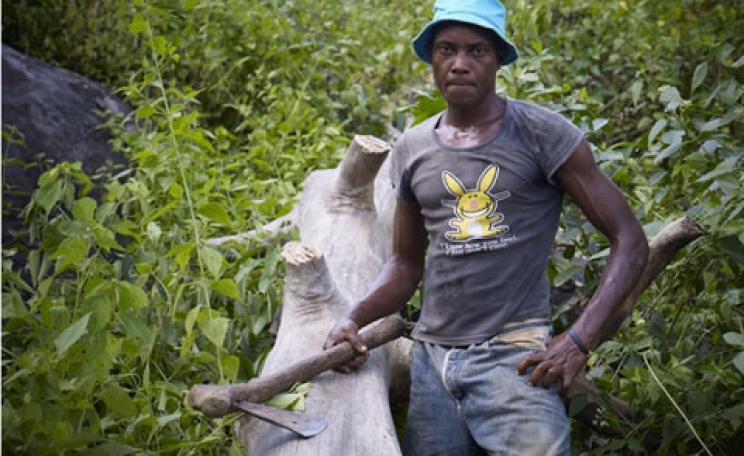The Amazon rainforest is the greatest of its kind on Earth, covering five and a half million of the Amazon Basin’s seven million square kilometres. It is the archetypal wilderness, a land criss-crossed by waterways originating in the Andes and extending as life-giving capillaries through primordial forests. It is home to 10 per cent of all species in existence. It is also under siege.
According to some estimations, the majority of the world’s tropical rainforest will be gone by 2050. In Brazil, which contains 60 per cent of the Amazon, 90 per cent of deforestation is illegal encroachment caused by poorly enforced, unclear, overlapping and often dubious land entitlements.
One widely discussed approach to tackling the problem is the UN REDD (Reducing Emissions from Deforestation and Degradation) programme, under which financial rewards are given by industrialised countries to their less industrialised counterparts for not cutting down their forests. In theory it's a good idea, but some REDD schemes have been criticised for lacking proper monitoring and enforcement, and inadequately consulting and protecting indigenous and local communities.
But REDD is not all bad news, and innovative projects are tackling its inherent problems head on. The Juma Sustainable Development Reserve (SDR) in Amazonas State is the first Brazilian REDD initiative. Funds raised will hopefully allow the state government to install effective enforcement and monitoring controls and contribute to sustainable development. It is hoped the project will save 444,541 hectares of forest and prevent the release of 253m tons of CO2. An innovative corporate partnership with hotel chain Marriot International has raised hopes that the model can be applied to the state’s thirteen other SDRs by establishing new company partnerships willing to sustain them.
Juma largely sidesteps REDD’s monitoring and auditing failures as it uses what is known as the 'Bolsa Floresta' (Forest Bursary) approach. This provides resident families with a monthly payment of R$50 and direct access to clean water, healthcare and education in return for participating in conservation training and making a zero-deforestation commitment. The scheme does not govern the communities; it encourages them to found ‘dwellers associations’ to govern themselves.
Juma will only have a future, however, if the cashflows that REDD provides prove generous enough. Although there were positive noises towards increased REDD funding at the ill-fated COP15 Copenhagen climate summit in December 2009, it remains one of the many areas still to be agreed upon.
But forest conservation need not be completely at the mercy of the international carbon markets. Another Bolsa Floresta-based initiative in Amazonas State is largely independent of REDD funding, and may be a model for how forest carbon and ecosystems can be preserved whilst politicians continue to fiddle.
A way forward
The 11,240 km2 Mamirauá SDR (MSDR) covers an area of flooded forest known as varzea. Varzeas comprise 150,000 square kilometers of the Amazon basin, around 3 per cent, and are regions of rainforest that are partially inundated during a seven month long wet season. They have been called ‘cradles of speciation’ as they are vital contributors to the overall ecology of the Amazon, allowing for the movement and dispersal of animals and plants when the waters rise, and their isolation when the waters subside. The MSDR provides a haven for 300 different birds, over 50 mammals, 400 fish and an endless diversity of invertebrates and plant life.
The MSDR is the vision of late forest ecologist José Márcio Ayres. His aim was to create a working model of the ‘people in protected area’ approach. The strengths of the MSDR lie in the fact that it excels in those areas that REDD does not. The project improved upon REDD’s monitoring and auditing failures by regarding local communities as themselves agents of conservation. A participatory management plan was drawn up between Mamirauá Institute for Sustainable Development (IDSM) scientists and the 12,000 residents of the protected areas. Such communities overwhelmingly rely upon logging and fishing, particularly of the dwindling Pirarucu fish, to sustain their livelihoods. The strategy identified where and how legitimate residents and users living within protected areas could profitably and legally harvest the resources within them. However, the community was also given the responsibility of safeguarding biodiversity through carrying out conservation and monitoring activities in a community-based surveillance system. Any restrictions on harvestable quotas were compensated by a share of the revenue from ecotourism.
The MSDR approach also appreciated that an alliance between traditional and scientific knowledge was the best way forward. In effect, says Dr Miguel Angel Pinedo-Vasquez of Columbia University, the approach has shifted from asking ‘How do we save the rainforest?’ to ‘how do we save the Amazonians, because it is they who are going to save the Amazon’. This was a dramatic change of emphasis: instead of paying communities to keep forests standing by hiring guards and relying upon markets, Marcios' plan turned communities from residents of the reserve to partners in its management.
A learning curve
The MSDR has been not been without its problems, however. The relationship with its sponsor, the UK Department for International Development (DfID), lacked clear lines of communication and this led to misunderstandings as to what the initiative was actually trying to achieve.
Cristina Inoue, who co-wrote the IIED report and is now a professor at the University of Brasilia’s Institute of International Relations, says this was rooted in policy changes within DfID. The then Secretary of State for International Development, Clare Short, viewed environmental projects as a side issue compared to the ravages of poverty, and insisted on a shift of focus specifically onto poverty reduction. The MSDR team prioritised the sustainable use of biodiversity. Failing to appreciate the inter-connectedness of these issues in subsistence societies, DfID refused to extend its funding which caused the project to close temporarily in 2002. For DfID, says Inoue, it was ‘too expensive a project, too much to help too few people’.
The MSDR also faced opposition from commercial logging and fishing groups, and also the Regatoes. These outside traders exploit local communities by obtaining their produce, such as fish and timber, for very low prices and exchanging them for essential goods, such as medicine and diesel, for an exorbitantly high price. They are often the only trading link through which communities can sell goods to the outside world, and without representative and collaborative institutions, this patron-client relationship had become deeply entrenched.
But these problems are slowly being tackled. Marcios realised that for mechanisms to work and funding to be attained, strong institutions are needed on a permanent basis. To this end, communities were given a key role in marketing their own products by creating community associations. The Sociede Civil Mamiraua (SCM) was founded in 1992, linked to and funded by the Ministry of Science and Technology, to coordinate what it called an 'Economic Alternatives Programme'. Amongst other successes, the SCM has contributed to a rise in the average household income within the MSDR of between 50 and 99 per cent in some areas, whilst overseeing the stabilisation and increase in a number of key wildlife populations.
A model for the future?
So could it work elsewhere? Some worry that replicating the MSDR model could be hampered because it is very much the product of the varzea environment, which has implications for how infrastructure is embedded within different habitats. It requires a set of ingredients - notably high levels of biodiversity - to get scientists interested, and socio-economic incentives to get communities on board.
However, the general situation at Mamiraua is not unique: there are poorly governed resource-rich regions the world over requiring protection in the face of growing human needs. To this end, the MSDR has set a life-saving trend. Marcios' pragmatism allowed him to dream the virtually impossible, the creation of SDRs linked by ecological corridors, five in the Amazon and two in the Atlantic Forest. Slowly, his dream is coming to fruition. In 1997 the Brazilian government created the 22,000 square kilometre Central Amazonian Corridor by linking the MSDR and its sister reserve, the Amana SDR, with the Jau National Park. Several other reserves have also been founded across Brazil and there are negotiations for the construction of further corridors spanning biomes and borders, with Ecuador and Paraguay, among others, answering the call.
Unanswered questions
Admittedly, there are certain questions to which the SDR approach in isolation has no answer. Water pollutants originating outside of the reserve, for example, require an external solution. Some, whilst acknowledging the merits of the SDR approach, question its conceptual foundations. ‘How can you do "sustainable" development?’ asks Inoue, ‘we just don’t know yet’. Improved health and higher incomes are great, she argues, but if replicated on a larger scale ‘we could get a form of consumerism which means more use of water and electricity and more garbage, in the middle of a river so that you cannot do anything about it’.
Inoue notes that the MSDR team has not explored ‘alternative development’ methods, incorporating a wider debate on how we see life, material goods and equality when we enjoy increasing livelihoods.
Most believe that it will take all sorts of policy combinations, SDRs, protected areas, indigenous reserves and everything else in between to save the Amazon. There is little doubt that many conservation efforts will continue to look to REDD for funding, but if REDD focuses too much on carbon emission reductions it is unlikely to spawn attractive projects.
If, however, REDD policymakers start to see conservation as more of a social issue, and incorporate social values and local ownership within its remit, then there is hope. That would give the SDR approach - of handing power and responsibility for managing reserves over to their inhabitants - a real chance to shine.
Nicholas Bruschi is a freelance journalist
| READ MORE... | |
 |
NEWS 'Perverse subsidies' to blame for wildlife loss, says UN Promises to reduce biodiversity loss by 2010 have not been met by any national government, according to the UN, which is calling for taxes and incentives to encourage action |
 |
NEWS Red List of endangered species needs to be tripled, say ecologists Current conservation list criticised for being biased towards vertebrates and neglecting most plants, fungi and invertebrates |
 |
NEWS Heavy bee colony losses in US could lead to price rise Beekeepers in US blame weather and starvation for another winter of heavy colony losses, which is likely to lead to rises in the cost of pollination |
 |
NEWS ANALYSIS Dead Sea pipeline plan an ‘ecological disaster’ Simple water conservation rather than a multi-billion pound pipeline project would be the best way to save the Dead Sea from disappearing, say environmentalists |






